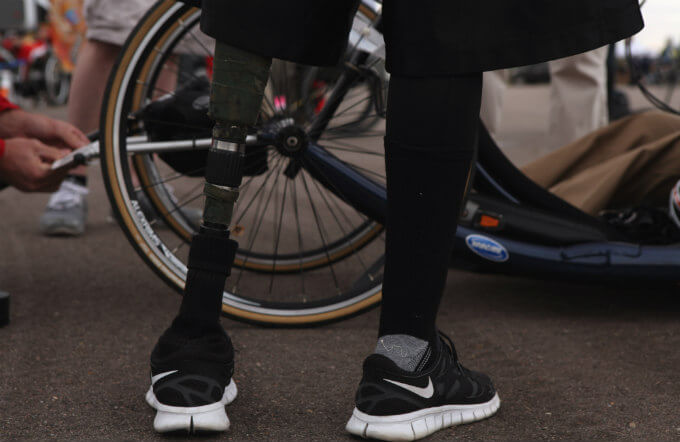
How often do we say “Break a leg!” when we wish someone good luck? And why do we say that instead of just the plain and direct to the point “Good luck!”? Ironically, some believed that wishing someone good luck is considered bad luck so they say it in an entirely different way.
But for amputees, breaking a leg may not be as nice as a good luck wish but can be exactly the opposite; a really bad luck.
There are many reasons people would need amputation. The most common are the following: severe injury from accidents or serious burns, cancerous tumors of the bone and muscle, infections that cannot be cured by antibiotics, neuroma, and frostbite.
But unlike some animals that can regrow or regenerate body parts that have been lost or mutilated for some reasons, humans cannot. Good thing people can still do something to improve their lives despite having handicaps. One of them is through the use of prosthetics.
A prosthetic leg is designed to replace the severed leg due to the reasons mentioned above and to follow the natural movement of the leg. But considering its functionality, how much does a prosthetic leg cost?

Average Cost of Prosthetic Leg
The price of prosthetic legs ranges from $5,000 up to $120,000 depending on the materials and technologies used that were based on the how much of the amputee’s leg has been left, the age, the kind of activities he or she does, among others. Therefore, the cost is not always the determinant as to whether the prosthetics are medically appropriate or not.
And unlike orthotics that can be available over-the –counter, these prosthetics are custom-made to perfectly fit the size, length and the body weight of the amputees for better movement and to be able to continue living like normal people does.
Prosthetics can also be moved or mind-controlled or computerized. They can be made of different materials like aluminum, stainless steel, titanium, plastics, or carbon composites depending on the preference of the amputee or his or her needs.
For the basic types like the mechanical and pneumatic prosthetics, the cost ranges from $5,000 to $40,000. The mechanical prosthetics provide constant friction and the pneumatic limb prosthetics are the ones operated by air or gas under pressure.
High-end prosthetic leg cost ranges between $40,000 and $60,000 like the C-leg which is considered the closest thing to a human leg.
But considered the highest and the most expensive type of prosthetics is the Genium X3 knee which was developed with the Department of Defense in the aim of letting soldiers with lower-limb amputations to return to active duty. This $120,000 worth of bionic leg is dust and waterproof, saltwater resistant when used for swimming, and runs silently.
Additional Costs
If you think that your prosthetics could last forever being so expensive, think again. Because of a lot of factors, you could expect your artificial leg to last for only about a few years until you buy another one.
One of the most common factors is age. And this is especially true for younger people. As you grow up, your prosthetics would not grow with you so you would need to change your artificial leg every so often.
Another one is wear and tear. Since your legs carry your body weight, your prosthetics would likely be damaged soon because of the load.
And speaking of load, the heavier you become, the more likely you would need to replace your prosthetics sooner than people with light or average weight.
Shopping for Prosthetic Leg
When looking for a provider of a prosthetic leg, ProsthetistFinder.org offer a locator based on your location.
If you need any information about leg loss or any limb loss, the AmputeeCoalition.org provides their services free of charge.
Factors Affecting Cost of Prosthetic Leg
Several factors that affect the price of prosthetic legs are the following:
- Age – the age of the amputee comes into the picture as little children and young adults tend to be more physically active and would need a sturdier leg. Also because children have no sense of discipline yet and might be accident prone if the artificial leg’s material is not strong enough. It might also be, that the age would determine if the amputee would be fit to wear them or not.
- Need – you need the prosthetic leg basically to feel complete again and to be mobile. But if you need it for something else like if you need to join a sports event for the handicapped or you need it more sophisticated like you want your designer bags or sports car, prepare to pay a higher price.
- Amputee’s residuum – the amount of the leg part that was left determines how long the prosthetic needs to be and if you need a joint for the knee or not.
- Materials – the type of material your artificial leg is made up of basically determines how much you have to pay for the prosthetic leg.
- Weight – your weight determines how sturdy your artificial leg needs to be in order to carry your weight.
- Technology – most prosthetics are made just to improve your quality of life by giving you more mobility than using wheelchairs or crutches. But if you want to have an artificial leg that can almost move on its own or can be operated by mere thoughts of your brain, prepare a fortune for the price.
- Insurance – most insurance companies would cover part or full amount of your prosthetic leg depending on the type and function. Those which are used for improved mobility alone are covered, while those which are intended for aesthetics purposes especially those high-end and those which are used to be able to join sports activities will naturally not be covered.
The prosthetic leg cost may literally be equivalent to “an arm and a leg” but at the end of the day, if it makes you feel good about yourself and it makes you feel normal again, just do it. After all, you have been deprived an ideal life when you lost a vital part of your body. It’s time to make yourself whole again and live your life to the fullest to your heart’s content.